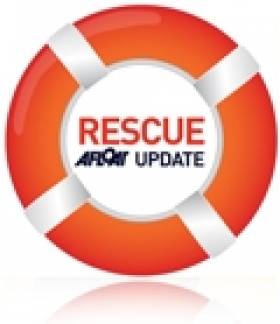Displaying items by tag: Garda
Garda Preps for Clipper Race Challenge
#Clipper - A serving member of An Garda Síochána has launched his bid to compete in the next edition of the Clipper Round-The-World Yacht Race.
Conor O'Byrne, who describes himself as "a keen sailor" with a "burning desire of sailing around the world", has started a blog to record his preparations for and participation in the race, the first leg of which kicks off from England this coming August.
The garda hopes to use his place in the epic voyage to raise awareness for the Irish Underwater Search and Recovery Unit, but also has more personal reasons in mind for the challenge.
"My reason for undertaking the race and being such a long time away from home and sailing in some of the world's most punishing seas was to hopefully build on my character and to learn more about myself and other people in the most extreme conditions.
"I like to be pushed beyond my comfort zone as I enjoy a challenge."
Follow Conor's preparations for the year-long race - which takes a route via South America, South Africa, Australia, China, the USA, Panama, Canada and Northern Ireland - at his Garda Around The World blog HERE.
Garda Investigates Waterford Seal Shootings
#MARINE WILDLIFE - Newstalk reports that gardaí are investigaing the shooting of seals on a Waterford beach.
As previously reported on Afloat.ie, fears are mounting of an illegal cull of marine wildlife in the area after a seal and a dolphin were found dead from gunshot wounds within a day of two seals being discovered with similar wounds.
All four animals were found along the same stretch of Tramore Beach late last month.
A spokesperson for the Irish Seal Sanctuacy pointed the finger at an illegal cull allegedly carried out by local fishermen.
The Irish Wildlife Trust has welcomed the Garda investigation into the incidents, and has called on the public to report any relevant information they may have.
Search Continues for Three Fishermen Still Missing in West Cork
#NEWS UPDATE - The search is set to resume again this morning for the three fishermen not yet recovered after their trawler sank off West Cork last Sunday.
Skipper Michael Hayes and Egyptian crewmen Saied Ali Eldin and Wael Mohammed have been missing since the fishing vessel Tit Bonhomme ran aground and went down in rough seas near Adam's Rock, at the mouth of Glandore Harbour.
Only one of the six-person crew, 43-year-old Abdul Mohammed, is confirmed alive after he was able to reach the shore immediately following the incident.
As previously reported on Afloat.ie, Garda divers retrieved the body of Attia Shaban (26) on Thursday morning, followed in the afternoon by that of Kevin Kershaw (21).
Yesterday the search was expanded to cover an 18-mile radius after a dive at the wreck site was unsuccessful, according to The Irish Times.
Divers from the Garda and Naval Service will continue to focus on the wreck today, helped by favourable weather conditions, while volunteers join in the wider search of the coastline.
It emerged on Friday that that boat's aluminium wheelhouse sheared off in the rough seas that followed for three days after it ran aground.
RTÉ News has video of the search operation in progress HERE.
Body Recovered as Search for West Cork Fishermen Continues
#RESCUE - Garda divers have this morning recovered a body in their search for the crew of the fishing vessel Tit Bonhomme off the coast of West Cork.
As previously reported on Afloat.ie, five of the six-person crew went missing after the boat ran aground and went down rough seas near Adam's Rock, at the mouth of Glandore Harbour.
The five men include skipper Michael Hayes from Helvic Head in Co Waterford, Dubliner Kevin Kershaw (21) and Egyptians Said Mohammed (23), Wael Mohammed (35) and Attea Ahmed Shaban (26).
RTÉ News reports that the body recovered this morning has not been identified, but it is believed to be that of an Egyptian national.
Dive teams from the Garda and Naval Service have been set back by the trawler's position wedged in a narrow inlet with strong wash and backwash on either side, but were said to have made "significant progress" during dives yesterday.
A broader search is also being conducted inside and outside the harbour area and surrounding coastline, assisted by fishing boats, Irish Coast Guard rescue helicopters, and small boats and kayaks.
While it might be an exaggeration to say that all of the 21 crew members of Rambler 100 owe their lives to the Irish Search and Rescue service, there are certainly five people whose future prospects were greatly improved by the operation off the Fastnet Rock on August 15th. A lot of media focus has been on Coxswain Kieran Cotter and the crew of Baltimore Lifeboat as well as lifeboat mechanic Jerry Smith, whose dive boat, on charter to the media team of one of the competitors, was on hand to search and recover the five drifting crew. There is no question that this focus is appropriate. RNLI crews all over the UK and Ireland deserve the attention, not only because of their extraordinary voluntary dedication to the cause, but also because such publicity helps swell the coffers of the charity. The service could not operate without the generosity of the donors and incidents such as these help fill the blue boat-shaped boxes held by even more RNLI volunteers.

Saved: Ireland's Rescue Services Answered the Call of the capsized Supermaxi Rambler 100 off the Fastnet Rock. Photo: Team Phaedo
The dramatic stories and pictures dominating the media show the front line of a quite wonderful resource that is Search and Rescue in Ireland today. Baltimore Lifeboat was at the coal face of an intricate network of operations, triggered by the crew's EPIRBs. Irish Coast Guard radio officers in Valentia responded almost immediately tasking the rescue resources, working the phones and computers to confirm that this was not an accidentally triggered EPIRB, contacting RORC HQ, determining search patterns and relaying the information to the scene. It was the backroom contacts between RORC and the Coast Guard in endeavouring to contact Rambler 100 using satellite phones that confirmed the possibility of a catastrophic incident involving the Supermaxi. The subsequent tasking of the Shannon and Waterford based Sikorsky helicopters led to the medevac of crew member Wendy Touton and timely treatment of her hypothermic condition, initially by the on-board paramedics and later at Tralee General hospital. And Coast Guard involvement didn't end with the successful rescue – the shoreside operation to provide food and shelter in Baltimore was coordinated by Coast Guard personnel and the salvage operation of the hull of Rambler 100 was overseen by the Irish Coast Guard.

Rambler crew are recovered from the water after a SAR operation by the Irish Coastguard Photo: Team Phaedo. More photos here.
That Ireland has probably one of the best Search and Rescue services in the world goes back to the campaign initiated in 1988 by Joan McGinley, following the death, within sight of land of Donegal fisherman John Oglesby, whose leg was severed in a trawl winch. Eamon Doherty, the late former Garda Commissioner chaired the review group established in response to the campaign and his report led to the establishment of the Irish Marine Emergency Service, subsequently the Irish Coast Guard. Under the guidance of Director Capt Liam Kirwan, the new service moved quickly to become not only the central co-ordinating body for Search and Rescue, but developed its own resources, notably the helicopters, previously tasked in from Irish Air Corps and UK SAR.
Another element that will feature in the Rambler 100 incident is the Marine Casualty Investigation Board (MCIB), set up from recommendations arising from a review of the handling of investigations into marine casualties.
It might be thought that the incident is now closed, but there are many unanswered questions and the investigation will be looking at these and making recommendations that should improve safety in this sector. These questions will include EPIRB performance, liferaft deployment and grab bag usage, but perhaps the key issue yet to be determined is why the response from fellow competitors didn't appear to happen. Even if Channel 16 wasn't being actively monitored, and if not why not, shouldn't the Mayday set off by the Coast Guard have set off the DSC alerts on the radios of Rambler 100's fellow competitors? Had the incident occurred several hours later or earlier when Rambler 100 could have been up to 100 miles from the nearest land, when conditions worsened, we could be looking at much more serious consequences.
It is heartening to think that, in this small country of ours in troubled times, not only do we have a shining star in our search, rescue, recovery and restore system, involving professionals and volunteers cooperating for the greater good, we also have a system that determines the nature of incidents so that we can all learn from the experience.
And let us not forget those people and services, such as the Gardai, Navy, Army and the community of Baltimore who are outside the media spotlight who contributed to this happy ending.
Afloat's Latest Coastguard News
Afloat's Latest RNLI Lifeboat News
Afloat's Latest MCIB News
Flood Evacuation Exercise in Fingal This Weekend
Members of the public are invited to attend a major flood evacuation training exercise this Saturday at Broadmeadow Esturary in Swords, Co Dublin.
Rescue and boat rescue crews from the Irish Coast Guard are sceduled to join teams from the Dublin Fire Brigade, the Civil Defence Fire Service and Gardaí in the exercise, which will simulate the rescue of a group of people stranded after a flash flood.
The crews will test water rescue and river search procedures, with an emphasis on general water safety and providing assistance to other search and rescue agencies.
The excercise will begin at 11am on Saturday 16 April and will last for one hour. Members of the public are welcome to observe must must obey any instructions and must not interefere with the exercise.
For more information contact Bill Powderly, assistant chief Civil Defence officer with responsibility for the Fingal Area, at [email protected] or 086 380 5197.


































































